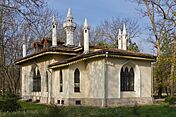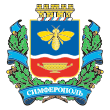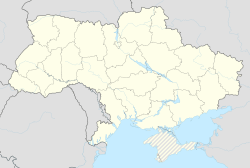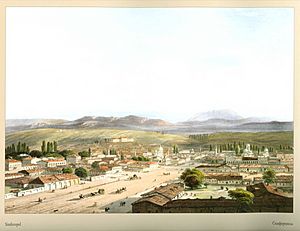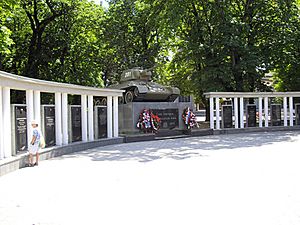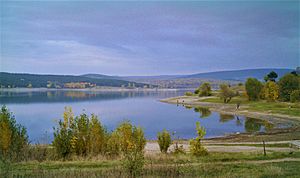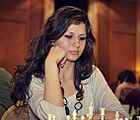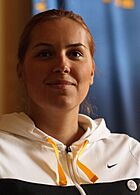Simferopol facts for kids
Quick facts for kids
Simferopol
|
|||
|---|---|---|---|
|
City
|
|||
| Ukrainian transcription(s) | |||
| • National | Simferopol | ||
| • ALA-LC | Simferopol′ | ||
| • BGN/PCGN | Simferopol’ | ||
| • Scholarly | Simferopol′ | ||
|
The railway station, Academic Drama Theater, Salgirka Park, Kebir-Jami, Trinity Cathedral, the State Medical University, Karl Marx Street
|
|||
|
|||
| Nickname(s):
Город пользы
The City of Usefulness (translation) |
|||
| Country | |||
| Autonomous republic | Crimea (de jure) | ||
| Raion | Simferopol Raion (de jure) | ||
| Federal subject | Crimea (de facto) | ||
| Municipality | Simferopol Municipality (de facto) | ||
| Founded2 | 15th century | ||
| Boroughs |
List
Zaliznychnyi District
Tsentralnyi District Kyivskyi District |
||
| Area | |||
| • Total | 107 km2 (41 sq mi) | ||
| Elevation | 350 m (1,150 ft) | ||
| Population
(2014)
|
|||
| • Total | 332,317 | ||
| • Density | 3,183.17/km2 (8,244.4/sq mi) | ||
| Demonym(s) | Simferopolitan | ||
| Time zone | UTC+3 | ||
| Postal code |
295000—295490
|
||
| Area code(s) | +7 3652 | ||
| Licence plate | AK(UA) 82(Rus) | ||
| Sister cities | Heidelberg, Kecskemét, Salem, Bursa, Eskişehir, Ruse, Nizhny Novgorod | ||
| Website | (Russian administration) | ||
| 1 United Nations General Assembly Resolution 68/262 2 Founded in 1784 as Simferopol, a Russian city. The settlement was previously known by the Crimean Tatar name Aqmescit. |
|||
Simferopol (/ˌsɪmfəˈroʊpəl/), also known as Aqmescit, is the second-largest city on the Crimean Peninsula. The city, along with the rest of Crimea, is internationally recognised as part of Ukraine, controlled by Russia, and is considered the capital of the Autonomous Republic of Crimea.
Since 2014 it has been under the de facto control of Russia, which annexed Crimea that year and regards Simferopol as the capital of the Republic of Crimea.
Simferopol is an important political, economic and transport hub of the peninsula, and serves as the administrative centre of both Simferopol Municipality and the surrounding Simferopol District. Its population was 332,317 (2014 Census).
After the 1784 annexation of the Crimean Khanate by the Russian Empire, the Russian empress decreed the foundation of a city named Simferopol on the location of the Crimean Tatar town of Aqmescit ("White Mosque").
Contents
Etymologies
The name Simferopol (Ukrainian: Сімферо́поль [sʲimfeˈrɔpɔlʲ]; Russian: Симферо́поль [sʲɪmfʲɪˈropəlʲ]) comes from the Greek Sympheropoli (Greek: Συμφερόπολη, romanized: Symferópoli, lit. 'city of common good'. The spelling Symferopil (Ukrainian: Симферопіль) is also used.
In Crimean Tatar, the name of the city is Aqmescit (or in Cyrillic, Акъмесджит, lit. 'The white mosque', from Aq "white", and mescit "mosque"). But aq does not refer to the colour of the mosque, but rather to its location in cosmology. The Turkic peoples give a colour designation to the cardinal points, and white is the west. Thus, the exact translation of the name of the town is "the Western Mosque."
In English, the name was often given as Akmechet or Ak-Mechet (e.g. in Encyclopædia Britannica),. This was a transliteration from the Russian spelling of Crimean Tatar word Акмечет, Ак-Мечеть, where Mechet (Мечеть) is the Russian word for "mosque".
History
Early history
Archaeological evidence in the Chokurcha cave shows the presence of ancient people living in the territory of modern Simferopol. The Scythian Neapolis, known by its Greek name, is also located in the city, which is the remnants of an ancient capital of the Crimean Scythians who lived in the territory from the 3rd century BC to the 4th century AD.
Later, the Crimean Tatars founded the town of Aqmescit. For some time, Aqmescit was the residence of the Qalğa-Sultan, the second most important position in the Crimean Khanate after the Khan himself. The area of the city once known as Aqmescit is today called Old Simferopol.
Russian Empire
In 1784 modern Ukrainian Simferopol was founded after the annexation of the Crimean Khanate to the Russian Empire by Catherine II of Russia. The name Simferopol is in Greek, Συμφερόπολις (Simferopolis) and literally means "the city of usefulness." The tradition of Greek place names in newly acquired southern territories began with the Greek Plan of Russian Empress Catherine the Great. In 1802, Simferopol became the administrative centre of the Taurida Governorate. During the Crimean War of 1854–1856, the Russian Imperial Army reserves and a hospital were stationed in the city. After the war, more than 30,000 Russian soldiers were buried in the city's vicinity.
20th-century wars
In the 20th century, Simferopol was once again affected by wars and conflicts in the region. At the end of the Russian Civil War, the headquarters of General Pyotr Wrangel, leader of the anti-Bolshevik White Army, were located there. On 13 November 1920, the Red Army captured the city and on 18 October 1921, Simferopol became the capital of the Crimean Autonomous Soviet Socialist Republic.
During World War II, Simferopol was occupied by Nazi Germany from 1 November 1941 to 13 April 1944. Retreating NKVD police shot a number of prisoners on 31 October 1941 in the NKVD building and the city's prison. Germans perpetrated one of the largest war-time massacres in Simferopol, killing in total over 22,000 locals—mostly Jews, Russians, Krymchaks, and Romani. On one occasion, starting 9 December 1941, the Einsatzkommando 11b, which was under the command of Werner Braune, whose main unit and superior were Einsatzgruppe D and Otto Ohlendorf, respectively, command killed an estimated 14,300 Simferopol residents, mostly Jewish.
In April 1944 the Red Army liberated Simferopol. On 18 May 1944 the Crimean Tatar population of the city, along with the whole Crimean Tatar nation of Crimea, was forcibly deported to Central Asia as collective punishment for the perceived collaboration of Tatars with Nazi Germany.
Ukraine
On 26 April 1954, Simferopol, together with the rest of the Crimean Oblast, was transferred from the Russian Soviet Federative Socialist Republic to the Ukrainian Soviet Socialist Republic by Soviet Premier Nikita Khrushchev.
An asteroid, discovered in 1970 by Soviet astronomer Tamara Mikhailovna Smirnova, is named after the city (2141 Simferopol).
Following a referendum on 20 January 1991, the Crimean Oblast was upgraded to an Autonomous Soviet Socialist Republic on 12 February 1991 by the Supreme Soviet of the Ukrainian SSR. Simferopol became the capital of the Crimean Autonomous Soviet Socialist Republic.
After the collapse of the Soviet Union in 1991, Simferopol became the capital of the Autonomous Republic of Crimea within newly independent Ukraine. Today, the city has a population of 340,600 (2006) most of whom are ethnic Russians, with the rest being Ukrainian and Crimean Tatar minorities.
After the Crimean Tatars were allowed to return from exile in the 1990s, several new Crimean Tatar suburbs were constructed, as many more Tatars returned to the city compared to number exiled in 1944. Land ownership between the current residents and returning Crimean Tatars is a major area of conflict today with the Tatars requesting the return of lands seized after their deportation.
Russian annexation
After Russia occupied and formally annexed Crimea on 18 March 2014, Simferopol was named the capital of a new federal subject of the Russian Federation encompassing the majority of the peninsula by decree of Russian president Vladimir Putin, with the exception of Sevastopol, which became a federal сity.
Prior to the seizure of the city by Russia, a mass protest was organised by the city's Crimean Tatars in support of Crimea remaining as part of Ukraine.
Geography
Location
Simferopol is located in the south-central Crimean Peninsula. The city lies on the Salhir River near the artificial Simferopol Reservoir, which provides the city with clean drinking water. The Simferopol Reservoir's earth dam is the biggest in Europe.
Climate
The city experiences a humid subtropical climate (Köppen: Cfa), near the boundary of the humid continental climate (Köppen: Dfa). The average temperature in January is 0.4 °C (32.7 °F) and 23 °C (73 °F) in July. The average rainfall is 501 millimetres (19.7 in) per year, and there is a total of 2,529 hours of sunshine per year.
| Climate data for Simferopol (1991–2020, extremes 1886–present) | |||||||||||||
|---|---|---|---|---|---|---|---|---|---|---|---|---|---|
| Month | Jan | Feb | Mar | Apr | May | Jun | Jul | Aug | Sep | Oct | Nov | Dec | Year |
| Record high °C (°F) | 20.8 (69.4) |
21.9 (71.4) |
28.7 (83.7) |
31.5 (88.7) |
34.2 (93.6) |
37.7 (99.9) |
39.3 (102.7) |
39.5 (103.1) |
37.2 (99.0) |
33.3 (91.9) |
28.0 (82.4) |
25.4 (77.7) |
39.5 (103.1) |
| Mean daily maximum °C (°F) | 4.1 (39.4) |
5.5 (41.9) |
10.2 (50.4) |
16.3 (61.3) |
21.9 (71.4) |
26.5 (79.7) |
29.8 (85.6) |
29.7 (85.5) |
24.0 (75.2) |
17.5 (63.5) |
11.1 (52.0) |
6.1 (43.0) |
16.9 (62.4) |
| Daily mean °C (°F) | 0.4 (32.7) |
1.1 (34.0) |
4.8 (40.6) |
10.2 (50.4) |
15.6 (60.1) |
20.2 (68.4) |
23.0 (73.4) |
22.8 (73.0) |
17.6 (63.7) |
11.8 (53.2) |
6.4 (43.5) |
2.4 (36.3) |
11.4 (52.5) |
| Mean daily minimum °C (°F) | −2.9 (26.8) |
−2.6 (27.3) |
0.4 (32.7) |
4.8 (40.6) |
9.9 (49.8) |
14.5 (58.1) |
17.0 (62.6) |
16.6 (61.9) |
12.1 (53.8) |
7.2 (45.0) |
2.7 (36.9) |
−0.8 (30.6) |
6.6 (43.9) |
| Record low °C (°F) | −26.0 (−14.8) |
−30.3 (−22.5) |
−18.4 (−1.1) |
−11.1 (12.0) |
−8.4 (16.9) |
0.7 (33.3) |
3.6 (38.5) |
3.8 (38.8) |
−5.1 (22.8) |
−11.4 (11.5) |
−21.7 (−7.1) |
−23.2 (−9.8) |
−30.3 (−22.5) |
| Average precipitation mm (inches) | 42 (1.7) |
34 (1.3) |
36 (1.4) |
33 (1.3) |
40 (1.6) |
58 (2.3) |
39 (1.5) |
47 (1.9) |
40 (1.6) |
45 (1.8) |
44 (1.7) |
43 (1.7) |
501 (19.7) |
| Average extreme snow depth cm (inches) | 1 (0.4) |
2 (0.8) |
1 (0.4) |
0 (0) |
0 (0) |
0 (0) |
0 (0) |
0 (0) |
0 (0) |
0 (0) |
0 (0) |
1 (0.4) |
2 (0.8) |
| Average rainy days | 12 | 11 | 11 | 11 | 10 | 11 | 8 | 7 | 10 | 11 | 13 | 14 | 129 |
| Average snowy days | 11 | 11 | 7 | 1 | 0 | 0 | 0 | 0 | 0 | 1 | 4 | 9 | 44 |
| Average relative humidity (%) | 85 | 81 | 75 | 68 | 69 | 67 | 63 | 61 | 68 | 76 | 82 | 85 | 73 |
| Mean monthly sunshine hours | 80.7 | 109.9 | 160.2 | 227.6 | 299.2 | 321.3 | 358.5 | 332.6 | 259.1 | 190.2 | 115.2 | 74.1 | 2,528.6 |
| Source 1: Pogoda.ru.net | |||||||||||||
| Source 2: NOAA | |||||||||||||
Transportation
Simferopol has a major railway station, which serves millions of tourists each year. In December 2014 Ukraine cut the railway line to Crimea at the border with mainland Ukraine (Kherson Oblast). Currently, the station serves only a commuter (regional) passenger train and the Moscow – Simferopol train every day.
The city is also connected via the Simferopol International Airport, which was constructed in 1936. Zavodskoye Airport is situated southwest of Simferopol.
The city has several main bus stations, with routes towards many cities, including Sevastopol, Kerch, Yalta, and Yevpatoriya. The Crimean Trolleybus connects Simferopol to the city of Yalta on Crimean Black Sea coast. The line is the longest trolleybus line in the world with a total length of 86 kilometres (53 mi) (since 2014 again 96 kilometres (60 mi)).
The streets of Simferopol have a rare house numbering – the odd numbers are on the right side of the road, looking in the direction in which the numbers increase.
Demographics
| Historical population | ||
|---|---|---|
| Year | Pop. | ±% |
| 1897 | 49,078 | — |
| 1926 | 88,000 | +79.3% |
| 1939 | 142,634 | +62.1% |
| 1959 | 187,623 | +31.5% |
| 1970 | 249,053 | +32.7% |
| 1979 | 301,505 | +21.1% |
| 1989 | 343,565 | +14.0% |
| 2001 | 343,644 | +0.0% |
| 2014 | 332,317 | −3.3% |
| 2021 | 340,540 | +2.5% |
| Source: Census data | ||
At the last census in 2014, the population of Simferopol was 332,317, the highest of any city in the Republic of Crimea and second only to Sevastopol within the Crimean peninsula.
Economy
When it existed, Crimea Air had its head office on the grounds of Simferopol Airport. A new 19-gate terminal for the airport finished construction in 2018. The terminal was designed in the shape of a wave by Samoo Architects & Engineers, after their successful bid as part of an international competition.
Industry
Simferopol is home to a number of industrial plants, including the following:
- Fiolent (two locations), producer of power tools and other electrical systems
- Simferopol chemical industry plants
- PO Foton
- SEM SElktroMash SELMZ
- Plastotekhnika and else plastics related
- Santekhprom SSTP
- PEK PromElektroKontakt and PromSchitKontakt, ChPO Sfera IzmertelnPribor, SELTZ ElectroTechnical Plant
- Pnevmatika, other pneumatics tires etc. related industry
- Monolit SMZKon, TsSI Tavrida SKMKZ, Slava Truda SCMNG, SiMZ Motor Plants
- Chornomornaftogaz
- Digital Valley (Tsifrovaya Dolina): silicon industry, computers, wafers and microelectronics, it, other related. It will located (most likely) near the airport for convenience.
Education
The largest collection of higher education institutions in Crimea is located in Simferopol. Among them is the largest university in Simferopol and Crimea, the Taurida V.Vernadsky National University, which was founded in 1917. Crimea State Medical University named after S. I. Georgievsky, also located in Simferopol, is one of the most prominent medical schools of Ukraine. The Crimean Medical University is situated on the plot, where in 1855 a nursery garden was planted by the founder of the Nikita Botanical Gardens Ch.Ch.Steven (1781–1863). In 1863–66 a school for girls was built here and in 1931 a medical institute was opened. On the same plot P.Krzhizhanovsky built a three-storey hostel for medical students after the design in 1934. The building with clear geometric masses was completed in 1938. A new federal university campus was opened 4 August 2014.
Sports
Simferopol is home to the football club FC TSK Simferopol which plays in the Crimean Premier League. It was formed as a Russian club in 2014, following the 2014 Crimean Conflict, to replace the Ukrainian club Tavriya Simferopol which had been the first winners of the Ukraine Premier League, and also won the Ukrainian Cup in 2010.
Houses of worship
- Kebir-Jami Mosque, Simferopol
- Holy Trinity Cathedral, Simferopol
Notable people
- Max Alpert (1899–1980) a Soviet photographer, front-line work during WWII
- Andrei Abrikosov (1906–1973) a Soviet stage and film actor.
- Reşat Amet (1975–2014) a Crimean Tatar activist
- Denis Bouriakov (born 1981), principal flautist of the Los Angeles Philharmonic
- Rachel Devirys (1890–1983) French film actress, starred in some 50 films from 1916 to 1956.
- Nadia Volodymyrivna Dorofeeva, professionally known as Dorofeeva (born 1990), female vocalist of the pop duo Vremya i Steklo
- Roman Filippov (1936–1992) a Soviet theatre and film actor
- Viktor Grebennikov (1927–2001) scientist, naturalist, entomologist and paranormal researcher
- Adolph Joffe (1883–1927) Communist revolutionary, Bolshevik politician and Soviet diplomat
- Sergey Karjakin (born 1990), Chess prodigy and grandmaster at age 12 years, 7 months
- Olexandr Kolchenko (born 1989) a Ukrainian left-wing anarchist, ecologist and archaeologist
- Oleg Kotov (born 1965), Air Force colonel, 15 Soyuz flight commander and flight engineer
- Andrey Kozenko (born 1981), a Russian and former Ukrainian statesman and politician.
- Nicolai Ivanovich Kravchenko (1867–1941) a Russian battle painter, journalist and writer.
- Anna Kuliscioff (1857–1925) Russian born Italian feminist, anarchist and Marxist socialist militant.
- Zara Levina (1906–1976) a Soviet pianist and composer.
- Saint Luke of Simferopol (1877–1961), born Valentin Felixovich Voino-Yasenetsky, Russian surgeon and Archbishop of Simferopol
- Yuri Manin (1937–2023) a Russian specialist in algebraic & diophantine geometry
- Alisa Melekhina (born 1991), chess master, attorney and classically trained ballerina
- Sergey Mergelyan (1928–2008), a Soviet Armenian mathematician and scientist
- Gennady Samokhin (born 1971) a Crimean speleologist, holds the depth world record of cave diving
- Ilya Selvinsky (1899–1968) was a Soviet Jewish poet, dramatist, memoirist and essayist
- Oleg Sentsov (born 1976) a Ukrainian filmmaker, writer and activist from Crimea.
- Valery Sigalevitch (born 1950), a Russian classical concert pianist, lives in La Rochelle.
- Bob Sredersas (1910–1982) a Lithuanian-Australian art collector.
- Alexei Stepanov (1858–1923), a Russian genre painter, illustrator and art teacher.
- Evhen Tsybulenko (born 1972), Estonian professor of international law
- Georges Vitaly (1917–2007), French actor, theatre director and theatre manager.
- Evgenii Wulff (1885–1941) a Crimean Russian Soviet biologist, botanist and plant geographer.
- Diana Tishchenko (born 1990), Ukrainian classical violinist
Sport
- Gleb Bakshi (born 1995) boxer, bronze medallist at the 2020 Summer Olympics.
- Lyudmila Blonska (born 1977), Ukrainian heptathlete, banned after 2 doping offences
- Serhiy Dotsenko (born 1979) Russian boxer, silver medallist at the 2000 Summer Olympics
- Andriy Hryvko (born 1983), a Ukrainian cyclist who rides for Astana
- Daniil Khlusevich (born 2001), Russian international footballer who plays for Spartak Moscow
- Yana Klochkova (born 1982), a Ukrainian swimmer with five Olympic medals, four being gold
- Natalia Popova (born 1993) former figure skater, five-time Ukrainian national champion
- Hanna Rizatdinova (born 1993), individual rhythmic gymnast, bronze medallist at the 2016 Summer Olympics
- Kateryna Serebrianska (born 1977), individual rhythmic gymnast, gold medallist at the 1996 Summer Olympics
- Oleksandr Usyk (born 1987), heavyweight boxer, gold medallist at the 2012 Summer Olympics
International relations
Twin towns – Sister cities
Simferopol is currently twinned with:
 Salem, Oregon, United States (1986)
Salem, Oregon, United States (1986) Heidelberg, Germany (1991)
Heidelberg, Germany (1991) Kecskemét, Hungary (2006)
Kecskemét, Hungary (2006) Tepebaşı, Turkey (2007)
Tepebaşı, Turkey (2007) Bursa, Turkey
Bursa, Turkey Irkutsk, Russia (2008)
Irkutsk, Russia (2008) Moscow, Russia (2008)
Moscow, Russia (2008) Novocherkassk, Russia (2008)
Novocherkassk, Russia (2008) Omsk, Russia (2008)
Omsk, Russia (2008) Ruse, Bulgaria (2008)
Ruse, Bulgaria (2008) Nizhny Novgorod, Russia (2016)
Nizhny Novgorod, Russia (2016)
See also
 In Spanish: Simferópol para niños
In Spanish: Simferópol para niños




